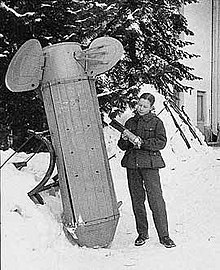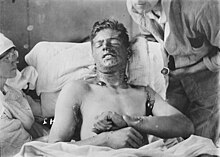Weapon of mass destruction
The term weapon of mass destruction ( english w eapon of m ass d estruction , WMD ) refers to a category of certain weapons that are considered to be particularly destructive and have a serious impact on life, objects and the environment. Today these include chemical , biological , radiological and nuclear weapons with which the enemy is to be militarily obstructed or eliminated.
The formulation used to exclusively used NBC weapons (ABC stands for A Tomar , B iologisch and C hemisch ) has been replaced by the designation CBRN ( C hemisch , B iologisch , R adiologisch and N uklear ). This corresponds to a division of the "A" threats into radiological (R) and nuclear (N) threats. “Nuclear” refers to nuclear weapon explosions and their consequences, as well as radioactive substances in the nuclear cycle; "Radiological" means other types of radioactive contamination , primarily in the form of a radioactive dispersion device (e.g. " dirty bomb ").
The similar term means of mass destruction is used more broadly: not only for military weapons , but also for firearms or small arms, or for pesticides and herbicides that are sprayed for pest control or warfare. Kofi Annan , the former Secretary General of the United Nations , remarked verbatim in October 2000 on the occasion of his We the Peoples Millennium Speech on the uncontrolled proliferation of small arms: “The blood toll imposed by small arms eclipses that of all other weapon systems […]. With regard to the carnage they cause, small arms can very well be described as means of mass destruction. ” (“ The death toll from small arms dwarfs that of all other weapon systems […]. In terms of the carnage they cause, small arms could well be described as weapons of mass destruction. ")
Use of the term
The term weapon of mass destruction was first used in 1937 by Archbishop of Canterbury Cosmo Gordon Lang . He wrote an article in the Times about the air strike on Gernika .
The UN resolution for the creation of an Atomic Energy Commission (a forerunner of the IAEA ) used the phrase in 1946: "... atomic weapons and of all other weapons adaptable to mass destruction".
In 1948, the United Nations Commission on Conventional Armaments used the term to delimit conventional weapons .
As a rule, when they are used, collateral damage occurs that was not intended by the user, but accepted . However, the limitation of the term weapon of mass destruction to NBC weapons is controversial, as the destruction by conventional weapons can exceed the effectiveness of NBC weapons, for example in World War II . However, the proliferation of weapons of mass destruction is seen as an avoidable threat to global security.
US journalist Dan Rather described the spread of the term "Weapons of Mass Destruction" to justify the invasion of Iraq in 2003 as deliberate and "brilliant" propaganda by the US government aimed at masking the differences between nuclear and chemical weapons and such Build pressure on public opinion. Nuclear weapons were rightly feared, but their possession by Iraq was also considered very unlikely by government experts. Chemical weapons, on the other hand, would be manageable and the subject of training and equipment despite their threat to the military. He regrets that, despite this story, the term is still used uncritically by the media.
In the criminal law of the United States , the term weapon of mass destruction was in the context of terrorist attacks after 2001 extended to all types of weapons in the States United code as a destructive device : define (about destructive explosive device). This also includes conventional bombs, missiles, grenades and mines with no effect on a large number of people.
Use of weapons of mass destruction
During World War II , the United States dropped two atomic bombs on Hiroshima and Nagasaki , while Japan used biological and chemical weapons in China . This makes World War II the only armed conflict in which warring parties used all available types of weapons of mass destruction. While the US-American use of nuclear weapons has remained the only one so far, biological and chemical weapons were also used in the First World War , the Korean War , the Vietnam War , the First Gulf War and the civil war in Syria .
Weapon types
Atomic

During the Second World War, the United States developed the first atomic bomb ( Manhattan Project ). The first missions were on August 6, 1945 over the Japanese city of Hiroshima and on August 9, 1945 over Nagasaki . The bomb over Hiroshima cost 130,000 lives on the day it was dropped, and by December 31, 2005 around 250,000 people were killed. The Nagasaki bomb killed 70,000 people immediately after the deployment and in the months after it. To date, the number of victims due to long-term effects has risen to around 140,000. In the eyes of some military officials, not all nuclear weapons are weapons of mass destruction. In certain cases, from a military point of view, they serve purposes such as air defense, against ship targets in the navy and for special areas of application such as satellite destruction, in which supposedly little or no people are harmed.
Biologically
Biological weapons are directed against humans, farm animals and useful plants or material. Their effect can often not be limited, especially with infectious pathogens . Due to the risk of epidemics, these weapons are particularly directed against civilian targets, while military organizations sometimes have suitable means of defense, such as protective suits, preventive protective vaccinations and, in the event of an infection, rapid diagnosis , antibiotics in sufficient quantities and the know-how necessary for treatment .
Pathogens that are easy to grow or that form stable spores are particularly dangerous. This includes:
|
|
Chemically
In World War I, on April 22, 1915, chemical weapons were used for the first time with greater effect by German troops on the Western Front, using the chlorine gas proposed by Fritz Haber as a weapon .
Given the horrors of World War I in 1925 in the Geneva Protocol on the prohibition of the use of chemical weapons and bacteriological agents banned the use of chemical weapons. The ban was largely observed during World War II, although not all participating countries had acceded to the protocol.
Since soldiers can protect themselves against chemical weapons relatively easily and efficiently, they are above all a great danger to the civilian population.
The defoliant Agent Orange used by the United States in the Vietnam War must, strictly speaking, be regarded as a chemical weapon due to its known toxic and carcinogenic side effects , especially since the high dioxin content of Agent Orange and its direct and indirect consequences were known to the responsible military according to information from human rights organizations .
Mustard compounds and organic phosphoric acid esters have become known as chemical warfare agents .
Conventional
Due to industrial manufacturing capabilities, conventional weapons can now be manufactured in large numbers and used to kill large numbers of people in a very short time. By definition, however, they are not weapons of mass destruction because a single bomb or grenade can only kill and / or injure a small number of people. Even area bombing does not count as weapons of mass destruction, despite the large number of victims. In the bombings of Coventry ( Great Britain ) and the city bombings of numerous German cities and metropolitan areas (e.g. Hamburg , Dresden ) during the Second World War, no weapons of mass destruction were used, even if tens of thousands of people were killed. The same applies (with the exception of Hiroshima and Nagasaki) to the numerous bombings of Japanese cities - people died on 9/10 in a single air raid on Tokyo alone . March 1945 over 100,000 people.

In the Vietnam War, the First and the Second Gulf War , the Afghanistan War , the US war in Afghanistan and similar conflicts hundreds of thousands of people have been killed by conventional weapons - far more than by weapons of mass destruction in the same period. Cluster bombs claim most of the civilian casualties due to the large number of duds in the submunition and the large area of impact.
"Peace Mission" of the nuclear weapon of mass destruction
During the Cold War , there was also a nuclear arms race between NATO and the Warsaw Pact , especially the United States and the Soviet Union . A balance of horror ( MAD , Mutual Assured Destruction ) has - in theory and practice - prevented both sides from using nuclear weapons. However, the danger of a possible overkill , i.e. the total annihilation of the whole of humanity with the multiple amount of the necessary funds in a global nuclear war , is still great today.
Since the atomic bombs were dropped on the Japanese cities of Hiroshima and Nagasaki in World War II , no nuclear weapon has actually been used in an armed conflict , even if their use has been repeatedly threatened.
See also
literature
- Liesbeth van der Heide: Cherry-Picked Intelligence. The Weapons of Mass Destruction Dispositive as a Legitimation for National Security in the Post 9/11 Age , in: Historical Social Research , Vol. 38, 1 (2013), pp. 286-308.
- Katrin Krömer: Weapons of Mass Destruction and NATO. The threat posed by the proliferation of weapons of mass destruction as a cooperation problem for the transatlantic alliance. Nomos Verlags-Gesellschaft, Baden-Baden 2003, ISBN 3-8329-0365-8 ( Nomos Universitätsschriften. Politik 122), (At the same time: Trier, Univ., Diss., 2002: The threat posed by the proliferation of weapons of mass destruction as a problem of cooperation between the transatlantic Alliance. ).
- Hans H. Kühl: Defense: protection against chemical, biological, radiological and nuclear threats in a changing security environment . Frankfurter Allgemeine Buch, Frankfurt am Main 2012, ISBN 978-3-89981-276-3 .
Web links
- Editor: ABC weapons. In: Historical Lexicon of Switzerland .
- Oliver Thränert: Danger from NBC weapons. - Article of the Federal Agency for Civic Education
Individual evidence
- ↑ www.bbk.bund.de: CBRN-Schutz - Federal Office for Civil Protection and Disaster Relief on Weapons of Mass Destruction, accessed on June 9, 2012.
- ↑ The pistol as a means of mass destruction - half a million people die every year from revolvers, hand grenades, machine guns and other so-called small arms. Unicef is therefore calling for a binding international arms trade agreement. , at stern.de on June 23, 2006, last accessed in February 2019.
- ↑ We the peoples: the role of the United Nations in the twenty-first century (Report of the Secretary-General), p. 38, paragraph 238, PDF (PDF; 878 kB) United Nations - General Assembly. Retrieved February 9, 2011.
- ^ Archbishop's Appeal. In: Times. (London), December 28, 1937, p. 9.
- ↑ cf. Daryll Howlett: Nuclear proliferation. In: John Baylis et al: The Globalization of World Politics. 4th edition. Oxford University Press , Oxford 2008, ISBN 978-0-19-929777-1 , p. 390.
- ^ Dan Rather: Why a Free Press Matters . In: The Atlantic, August 16, 2018
- ^ § 921. Definitions. In: United States Code. Cornell University Law School, accessed February 13, 2017 .
- ↑ § 2332a. Use of weapons of mass destruction. In: United States Code. Cornell University Law School, accessed February 13, 2017 .


